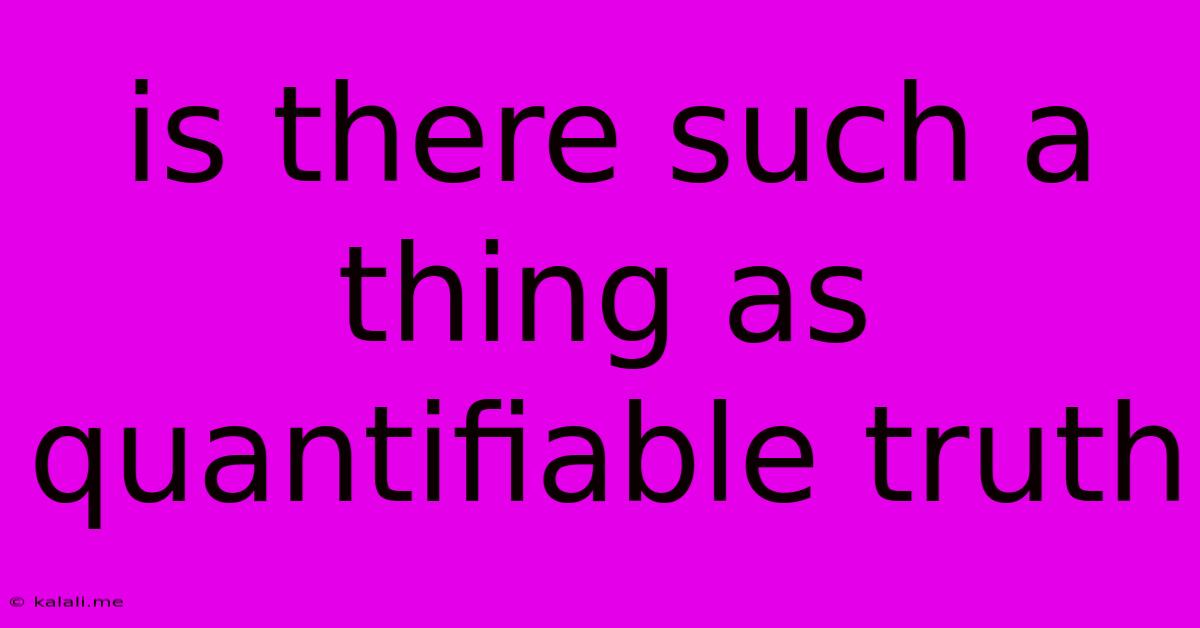Is There Such A Thing As Quantifiable Truth
Kalali
Jun 07, 2025 · 3 min read

Table of Contents
Is There Such a Thing as Quantifiable Truth?
The pursuit of truth has been a central theme throughout human history, driving philosophical inquiry and scientific discovery. But can we truly quantify truth? This seemingly simple question opens a complex debate spanning epistemology, metaphysics, and even mathematics. This article delves into the challenges of quantifying truth, exploring various perspectives and highlighting the nuances of this fundamental question.
The very notion of quantifying truth presents an immediate hurdle. Truth, in its purest sense, is often considered a binary concept: a statement is either true or false. However, assigning numerical values to truth often implies a degree of certainty or probability, blurring the lines of absolute truth. This leads us to consider different approaches to understanding "quantifiable truth."
Probabilistic Truth: A Measure of Belief
One approach involves assigning probabilities to statements. In this view, the "truth value" isn't a simple true/false, but rather a likelihood of being true, ranging from 0 (completely false) to 1 (completely true). This framework is common in Bayesian statistics and scientific modeling, where hypotheses are assessed based on evidence. For instance, the statement "it will rain tomorrow" doesn't possess a definitive true/false value, but a probability based on weather forecasts and historical data. This probabilistic approach allows for a quantification of belief, but it's crucial to remember that it quantifies belief, not inherent truth. The actual truth remains binary, even if our knowledge about it is probabilistic.
Fuzzy Logic and Degrees of Truth
Another perspective introduces the concept of fuzzy logic, where truth values are not restricted to binary states but can take on a range of values between 0 and 1. This is particularly useful when dealing with ambiguous or subjective concepts. For example, the statement "this apple is red" might be assigned a truth value of 0.8 if the apple is mostly red but has some green spots. Fuzzy logic provides a more nuanced approach to quantification, allowing for a greater degree of granularity in representing uncertainty. However, it still relies on subjective assessments and doesn't fundamentally alter the binary nature of truth itself.
Correspondence Theory and Its Limitations
The correspondence theory of truth posits that a statement is true if it corresponds to reality. While intuitively appealing, quantifying this correspondence poses significant challenges. How do we measure the degree of correspondence between a statement and a complex, multifaceted reality? Furthermore, our access to reality is always filtered through our senses and interpretations, introducing inherent limitations and potential biases. While we can strive for accuracy and precision, complete and objective correspondence remains elusive.
The Role of Evidence and Verification
The strength of evidence supporting a claim is often considered a proxy for truth. Scientific methodology relies on empirical evidence, rigorous testing, and peer review to build a strong case for a hypothesis. The amount and quality of evidence can be analyzed and quantified, but this quantification reflects the evidence, not the inherent truth of the claim. A strong body of evidence can increase our confidence in a statement's truth, but it doesn't guarantee its absolute truth.
Conclusion: Quantifying Belief, Not Truth
Ultimately, the question of whether truth itself can be quantified remains a complex philosophical debate. While we can quantify our belief in a statement, or the strength of the evidence supporting it, this doesn't equate to quantifying truth in its absolute sense. Truth, in its purest form, appears to remain a binary concept, defying attempts at numerical representation. However, the probabilistic and fuzzy approaches offer valuable tools for navigating uncertainty and dealing with incomplete or ambiguous information in our quest for understanding and knowledge. The pursuit of truth is ongoing, and the development of these tools allows us to refine our understanding and approach to it.
Latest Posts
Latest Posts
-
What Happens To Falcon Heavy Center Booster
Jun 07, 2025
-
Can You Put Plastic In The Oven
Jun 07, 2025
-
How To Dry Out A Book
Jun 07, 2025
-
How Much Space Does A Cat Need
Jun 07, 2025
-
Is Crushed Red Pepper The Same As Cayenne Pepper
Jun 07, 2025
Related Post
Thank you for visiting our website which covers about Is There Such A Thing As Quantifiable Truth . We hope the information provided has been useful to you. Feel free to contact us if you have any questions or need further assistance. See you next time and don't miss to bookmark.